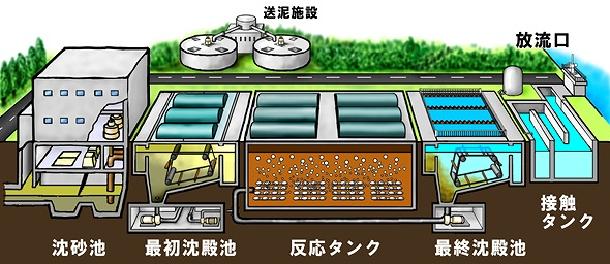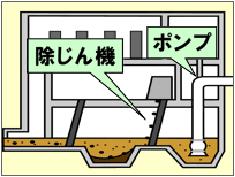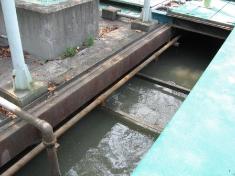- Yokohama-shi Top Page
- Living, procedures
- Community Development and Environment
- Rivers and sewers
- Sewer
- System of Sewage Treatment
- System of Sewage Treatment
The text is from here.
System of Sewage Treatment
Last updated on October 4, 2023.
Sewage discharged from homes and factories is transported to a water reclamation center through sewer pipes. The large amount of sewage is treated by a combination of physical, biological and chemical treatment at the water reclamation center.

Sand basin (physical treatment)
In sand basins, large garbage and stones are precipitated and removed.

The garbage is collected with a dust remover, the water is pumped up and sent to sedimentation pond first.

In the sand basin, water is slowly drained to remove large garbage.

A rough screen is installed to remove large pieces of wood.
First sedimentation pond (physical processing)
At first, it takes more time in sedimentation pond to settle small trash that could not be settled in the sand basin. These are removed as sludge (precipitated garbage), sent to the sludge recycling center, and processed.

Collect the sludge with a scraper.

It's the first entrance to sedimentation pond. The water is flowing slowly.

Waste that floats on the surface, such as oil, is also removed by a removal device.
Reaction tank (biological treatment)
The reaction tank is the heart of sewage treatment. By sending a large amount of air, microorganisms break down dirt dissolved in water. Microorganisms that decompose dirt and increase form a clump called flock. The flock looks like mud, so it is called activated sludge.
Click here if you want to know more about microorganisms in activated sludge.
Treatment of sewage by microorganisms

It sends fine air bubbles from the speror.

Sewage and activated sludge are mixed in the reaction tank. White bubbles are air.

It is a reaction tank that does not contain water. Air comes out of the blue disk lined up at the bottom.
Final sedimentation pond (physical processing)
In the final sedimentation pond, the activated sludge is slowly settled over time. This supernatant is called treated water. Part of the precipitated sludge is returned to the reaction tank again, and the rest is sent to the sludge adjustment tank for processing.

The precipitated activated sludge is collected by a scraper and sent to the reaction tank again by the returned sludge pump.

The supernatant after the activated sludge sinks is transparent.

The treated water flows out of the overflow on the surface of the pond.
Contact tank (chemical treatment)
In the contact tank, the treated water is disinfected with sodium hypochlorite. After that, it is released into rivers and seas.

Inject chemicals for disinfection near the entrance.

The water after chemical injection flows into the contact tank.

The contact tank is like a waterway and is disinfected while it flows slowly.
Sludge adjustment tank (physical treatment)
The sludge adjustment tank precipitates and concentrates sludge sent from the first sedimentation pond, the reaction tank, and the final sedimentation pond. The concentrated sludge is sent to the sludge recycling center and processed.
Inquiries to this page
Water Quality Section, Sewerage and Rivers Bureau Sewerage Facilities Department
Phone: 045-621-4343
Phone: 045-621-4343
Fax: 045-621-4256
E-Mail address [email protected]
Page ID: 132-154-875







